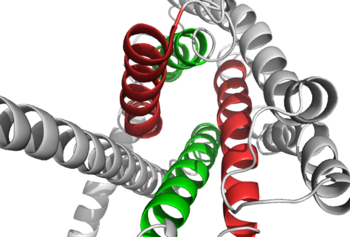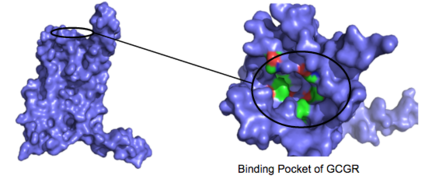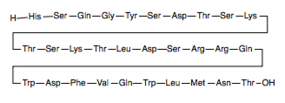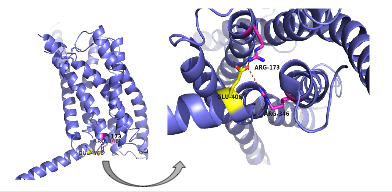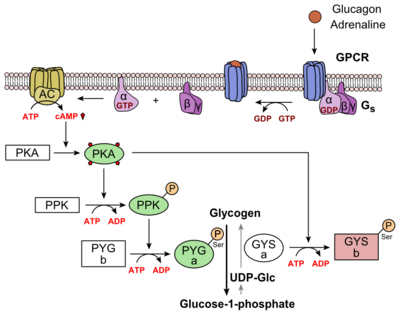Sandbox Reserved 1165
From Proteopedia
(Difference between revisions)
(New page: {{Sandbox_Reserved_CH462_Central_Metabolism}}<!-- PLEASE ADD YOUR CONTENT BELOW HERE --> ==Your Heading Here (maybe something like 'Structure')== <StructureSection load='1stp' size='340' s...) |
|||
| (245 intermediate revisions not shown.) | |||
| Line 1: | Line 1: | ||
| - | + | <StructureSection load='4l6r' size='350' side='right' caption='Structure of the Class B Human Glucagon G Protein Coupled Receptor-[http://www.rcsb.org/pdb/home/home.do PDB] [http://www.rcsb.org/pdb/explore/explore.do?structureId=4l6r 4L6R]' scene='72/721536/Class_b_gpcrs/4'> | |
| - | + | ==Human Glucagon Class B G Protein-Coupled Receptors (GPCRs)== | |
| - | <StructureSection load=' | + | |
| - | + | ||
| - | + | ||
| - | == | + | ===Introduction=== |
| + | '''Human glucagon class B G protein-coupled receptors (GPCRs'''), also known as [https://en.wikipedia.org/wiki/Secretin_receptor_family secretin-like receptors], are a subfamily of GPCRs and very similar in structure to the more well known class A ([https://en.wikipedia.org/wiki/Rhodopsin-like_receptors rhodopsin-like]) glucagon receptor family. <ref name="Intro">PMID: 24359917</ref> Located in the [https://en.wikipedia.org/wiki/Liver liver], class B glucagon receptors (GCGRs) are activated by the binding of the hormonal peptide [https://en.wikipedia.org/wiki/Glucagon glucagon]. Glucagon binding leads to the release of [https://en.wikipedia.org/wiki/Glucose glucose] into the [https://en.wikipedia.org/wiki/Circulatory_system bloodstream] and plays an essential role in [https://en.wikipedia.org/wiki/Blood_sugar_regulation glucose homeostasis]. Class B GCGRs are composed of a [https://en.wikipedia.org/wiki/Liver seven transmembrane domain] (7TM) and an [https://en.wikipedia.org/wiki/Liver extracellular domain] (ECD) that are required for glucagon binding. | ||
| - | == Disease == | ||
| - | == | + | =Structures of Class A vs. Class B GPCRs= |
| + | Class A vs. class B glucagon receptors share less than fifteen percent sequence homology, but both share a 7TM domain. <ref name="Intro">PMID: 24359917</ref> Understanding for class A family of GCGRs of the structure-function [https://en.wikibooks.org/wiki/Structural_Biochemistry/Enzyme_Catalytic_Mechanism mechanism] has made great progress over the past few years, but understanding of class B has fallen behind but is now catching up. <ref name="Tips">PMID: 23863937</ref> Comparison of the <scene name='72/721536/Final_1st_image/1'>class B 7TM</scene> helices to that of the <scene name='72/721536/Final_class_a_7tm/1'>class A 7TM</scene> helices showed that the general orientation and positioning of the [https://en.wikipedia.org/wiki/Alpha_helix alpha helices] are conserved through both classes. Detailed structural alignments of the two GPCR subclasses revealed multiple sequence misalignments in the transmembrane region signifying a variety of structural deviations in the transmembrane helices. <ref name="Tips">PMID: 23863937</ref> The N-terminal end of <scene name='72/721536/Final_helix_1/2'>helix one</scene> in class B GCGR, located in the 7TM, is longer than any known class A GPCR structure and stretches three supplementary helical turns above the extracellular (EC) membrane boundary. This region is referred to as the | ||
| + | <scene name='72/721535/stalk/1'>stalk</scene>. The stalk is involved in glucagon binding and helps in defining the orientation of the ECD with respect to the 7TM domain. <ref name="Tips">PMID: 23863937</ref> Also specific to class B GPCRs, a [https://en.wikipedia.org/wiki/Glycine Gly] residue at position 393 induces a <scene name='72/721535/Helical_bend/4'>bend in helix VII</scene>; this bend is stabilized by the [http://chemwiki.ucdavis.edu/Core/Physical_Chemistry/Physical_Properties_of_Matter/Atomic_and_Molecular_Properties/Intermolecular_Forces/Hydrophobic_Interactions hydrophobic interaction] between the <scene name='72/721535/Gly_393_phe_184/2'> glycine 393 and phenylalanine 184</scene>. One of the most distinguishable characteristics of the class B 7TM is the <scene name='72/721536/Class_b_helix_8_tilt_finals/1'>helix VIII tilt</scene> of 25 degrees and its length compared to that of <scene name='72/721536/Class_a_helix_vii_tilt/2'>class A helix VIII tilt</scene>, which is much shorter. This helical tilt results from [https://en.wikipedia.org/wiki/Phenylalanine Glu] 406 in helix VIII that is fully conserved in secretin-like receptors and forms two interhelical [https://en.wikipedia.org/wiki/Salt_bridge_(protein_and_supramolecular) salt bridges] with [https://simple.wikipedia.org/wiki/Conserved_sequence conserved residues] [https://en.wikipedia.org/wiki/Arginine Arg] 173 and Arg 346. <ref name="Tips">PMID: 23863937</ref> Despite these differences, a vital region that is conserved in both class B and class A receptors is the [https://en.wikipedia.org/wiki/Disulfide disulfide bond] between <scene name='72/721535/Disulfide_bond_notspin_actual/2'>Cys 294 and Cys 224</scene> in extracellular loop two (ECL2). This bond stabilizes the receptors entire 7TM fold. Lastly, the locations of the extracellular tips for class B glucagon receptors allow for a much wider and deeper [https://en.wikipedia.org/wiki/Ligand_(biochemistry) ligand-binding pocket] than any of the class A GPCRs. <ref name="Tips">PMID: 23863937</ref> These wide extracellular tip locations specifically occur between two sets of alpha helices, (Figure 1). | ||
| - | == Structural highlights == | ||
| - | + | ||
| + | [[Image:Colored_Helices_for_Proteopedia.png|(|):|350 px|center|thumb|'''Figure 1: Extracellular tips of the 7TM helices.''' Helices two and six are shown in green, while helices three and seven are shown in red]] | ||
| + | |||
| + | |||
| + | |||
| + | ==How These Structures Lead to Function== | ||
| + | |||
| + | [[Image:Closed and open conformation.png|(|):|250 px|left|thumb|'''Figure 2: Open conformation in contrast to the closed conformation.''' The movement of the single helix over the top of the transmembrane domain is the most distinguishable characteristic between closed and open conformation. The <scene name='72/721535/Stalk/1'>stalk</scene> is not accessible to glucagon in the closed conformation.<ref name="Lastt">PMID: 26227798</ref>]] | ||
| + | Structurally, the 7TM and its signature seven helical structure is involved in [https://en.wikibooks.org/wiki/Principles_of_Biochemistry/Signaling_inside_the_Cell signaling] via [https://en.wikibooks.org/wiki/Structural_Biochemistry/Energy_coupling_in_chemical_reactions coupling] to [https://en.wikipedia.org/wiki/Heterotrimeric_G_protein heterotrimeric G proteins] that activate [https://en.wikipedia.org/wiki/Adenylyl_cyclase adenylate cyclase] to increase the levels of intracellular [https://en.wikipedia.org/wiki/Cyclic_adenosine_monophosphate cyclic AMP]. Additionally, this coupling increases levels of [https://en.wikipedia.org/wiki/Inositol_phosphate IP3] and intracellular [https://en.wikipedia.org/wiki/Calcium calcium] levels. <ref name="Tips">PMID: 23863937</ref> The wider and deeper ligand-binding pocket of class B GPCRs allows for a vast array of molecules to be bound that in turn allow for numerous functions activated by peptide [https://en.wikipedia.org/wiki/Receptor_(biochemistry) receptors]. <ref name="Ligands">PMID: 21542831</ref> The conformation and orientation of the 7TM and the ECD regions dictate the functionality of the class B G protein-coupled receptor, which has an open and closed [https://en.wikipedia.org/wiki/Conformation conformation] of the GCGR (Figure 2). The open conformation is when glucagon can bind to GCGR; in the closed conformation binding does not occur.<ref name="Ligands">PMID: 21542831</ref> | ||
| + | |||
| + | |||
| + | [[Image:Screen_Shot_2016-03-22_at_5.28.03_PM.png|(|):|425 px|center|thumb|'''Figure 3: Binding Pocket Residues:''' Residues with side chains of carbon(utilizing the [https://en.wikipedia.org/wiki/Hydrophobic_effect hydrophobic effect]) are shown in green and side chains containing oxygen ([https://en.wikipedia.org/wiki/Hydrophile hydrophilic]) are shown in red. The properties of hydrophobicity and hydrophilicity of the residues create the [https://en.wikipedia.org/wiki/Ligand_%28biochemistry%29#Receptor.2Fligand_binding_affinity binding affinity] of glucagon.<ref name="Ligands">PMID: 21542831</ref> This image depicts the open conformation of GCGR.]] | ||
| + | |||
| + | The [https://en.wikipedia.org/wiki/Residue_(chemistry) residues] in the binding pocket that are in direct contact with the glucagon molecule are [https://en.wikipedia.org/wiki/Chemical_polarity polar] (utilizing the attraction of opposite charges or [https://en.wikipedia.org/wiki/Dipole dipoles] for glucagon binding) or are hydrophobic (utilizing the hydrophobic effect). The [https://en.wikipedia.org/wiki/Active_site binding site] location of the hormone peptide ligand has been identified, and the N-terminus of glucagon is known to bind partly with the ECD while the rest of glucagon binds deep into the binding pocket (Figure 3). The [https://en.wikipedia.org/wiki/Amino_acid amino acids] at the N-terminus of the class B 7TM have the ability to form [https://en.wikipedia.org/wiki/Hydrogen_bond hydrogen bonds] and [https://en.wikipedia.org/wiki/Ionic_bonding ionic interactions], which can be seen in the [https://en.wikipedia.org/wiki/Peptide_sequence amino acid sequence] of glucagon (Figure 4). <ref name="Sequence">PMID: 11946536</ref> | ||
| + | |||
| + | |||
| + | [[Image:Aminoacidsequenceglucagon.png|(|):|285 px|left|thumb|'''Figure 4: Amino Acid Sequence of Glucagon'''The primary sequence of glucagon, ligand to GCGR, is 29 amino acids.]] | ||
| + | [[Image:Glucagonstructure.png|(|):|360 px|right|thumb|'''Figure 5: Structure of Glucagon:''' The side chains of the residues making up glucagon are depicted. Coloration on the side chains indicate certain [https://en.wikipedia.org/wiki/Atom atoms] that determine the properties the residues hold. The blue indicates a [https://en.wikipedia.org/wiki/Nitrogen nitrogen] atom (hydrophilic properties), the green on the side chains indicates carbon atoms (non-polar hydrophobic properties), and the red coloration indicates an [https://en.wikipedia.org/wiki/Oxygen oxygen] atom (hydrophilic properties). [http://www.rcsb.org/pdb/home/home.do PDB] [http://www.rcsb.org/pdb/explore.do?structureId=1GCN 1GCN] ]] | ||
| + | |||
| + | |||
| + | There are specific amino acid interactions that maximize affinity. This includes the alpha helical structure of the <scene name='72/721535/Stalk/1'>stalk</scene>. The alpha helical structure of the stalk interacts directly with glucagon, as it extends nearly three helical turns above the membrane. When the alpha helix of the stalk is disrupted, the affinity of glucagon for GCGR decreases. A [https://en.wikipedia.org/wiki/Mutagenesis mutagenesis] study mutating <scene name='72/721535/Ala135/1'>alanine 135</scene> to a proline. Proline disrupts helices. The Ala135Pro mutant had significant lower affinity for glucagon.<ref name="Tips">PMID: 23863937</ref> Furthermore, there are certain interactions that hold the helices of the 7TM in the conformation that maximizes [http://www.chemicool.com/definition/affinity.html affinity]. <ref name="Ligands">PMID: 21542831</ref> The high affinity conformation of GCGR is the open conformation, when glucagon can bind. Without these specific interactions between the residues, the open conformation is not stabilized and GCGR remains in the closed conformation, where glucagon cannot bind. <ref name="Tips">PMID: 23863937</ref> The [https://en.wikipedia.org/wiki/Disulfide disulfide bond] between <scene name='72/721535/Disulfide_bond_notspin_actual/2'>Cys 294 and Cys 224</scene> serves to hold the helices in the proper orientation for binding and stabilizes the open conformation. Additionally, the [https://en.wikipedia.org/wiki/Salt_bridge_%28protein_and_supramolecular%29 salt bridges] between | ||
| + | <scene name='72/721535/Salt_bridge_residues/1'>Glu 406, Arg 173, and Arg 346</scene> hold the open conformation together for higher affinity (Figure 6). <ref name="Ligands">PMID: 21542831</ref> | ||
| + | |||
| + | |||
| + | [[Image:Screen Shot 2016-03-29 at 3.24.43 PM.png|(|):|420 px|center|thumb|'''Figure 6: Salt Bridge'''. The non-covalent interactions between residues <scene name='72/721535/Salt_bridge_residues/1'>Glu 406, Arg 173, and Arg 346</scene> form a [https://en.wikipedia.org/wiki/Denticity tridentate] salt bridge. The Glu 406 acts as the central residue in the tridentate salt bridge; Arg 173 and Arg 436 both [https://en.wikipedia.org/wiki/Chelation chelating] with Glu 406. The salt bridge is located on the intracellular side of the transmembrane helices.]] | ||
| + | |||
| + | |||
| + | |||
| + | ==Glucagon Signaling Pathway== | ||
| + | |||
| + | Glucagon binds to the open conformation of GCGR; the GCGR located on the [https://en.wikipedia.org/wiki/Cell_membrane plasma membrane]. Glucagon binding to GCGR induces a [https://en.wikipedia.org/wiki/Conformational_change conformational change] in GCGR. This conformation change induces the active state of the protein. The active state of the protein exchanges a [https://en.wikipedia.org/wiki/Guanosine_diphosphate guanosine diphosphate (GDP]) for [https://en.wikipedia.org/wiki/Guanosine_triphosphate guanosine triphosphate (GTP)] that is bound to the [https://en.wikipedia.org/wiki/G_alpha_subunit alpha subunit]. With the GTP in place, the activated alpha subunit dissociates from the [https://en.wikipedia.org/wiki/Heterotrimeric_G_protein heterotrimeric G protein's]beta and gamma subunits. Following dissociation, the alpha subunit can activate [https://en.wikipedia.org/wiki/Adenylyl_cyclase adenylate cyclase]. Activated adenylate cyclase, catalyzes the conversion of [https://en.wikipedia.org/wiki/Adenosine_triphosphate adenosine triphosphate (ATP)] into [https://en.wikipedia.org/wiki/Cyclic_adenosine_monophosphate cyclic adenosine monophosphate (cAMP)]. cAMP then serves as a secondary messenger to activate, through allosteric binding, [https://en.wikipedia.org/wiki/Protein_kinase_A cAMP dependent protein kinase A (PKA)]. PKA activates via [https://en.wikipedia.org/wiki/Phosphorylation phosphorylation] the [https://en.wikipedia.org/wiki/Phosphorylase_kinase phosphorylase b kinase]. The phosphorylase b kinase phosphorylates [https://en.wikipedia.org/wiki/Glycogen_phosphorylase glycogen phosphorylase b] to convert to the active form, phosphorylase a. Phosphorylase a finally catalyzes the release of [https://en.wikipedia.org/wiki/Glucose_1-phosphate glucose-1-phosphate] into the bloodstream from glycogen [https://en.wikipedia.org/wiki/Polymer polymers] (Figure 7). | ||
| + | |||
| + | [[Image:Glucagon_Pathway.png|(|):|400 px|center|thumb|'''Figure 7: [https://en.wikipedia.org/wiki/Glucagon Metabolic Regulation of Glycogen by Glucagon.]'''Depicted is the visualization of the glucagon signaling pathway through the GCGR. The location of the GCGR, the release of the alpha subunit from the beta and gamma subunits, and the enzyme cascade to result in the releasing of glucose are depicted. Abbreviations for the enzymes in the cascade include- PPK: phosphorylase kinase; PYG b: glycogen phosphorylase b; PYG a: glycogen phosphorylase a.]] | ||
| + | |||
| + | |||
| + | =Clinical Relevancy= | ||
| + | Of the fifteen human class B GPCRs, eight have been confirmed as potential [https://en.wikipedia.org/wiki/Biological_target drug target]. <ref name="Drug">PMID: 24628305</ref> However, overall family B GPCRs have been difficult drug targets. This difficulty is partially related to the inherent flexibility in the class B GCGR 7TM. The flexibility comes from the ability of GCGR to be a receptor many ligands. The GCGR's interactions on the extracellular side of the receptor may provide evidence to how class B receptors adjust the conformational spectra for various ligands. Researchers hope to show how these conformations can be utilized in potential treatments of a wide array [https://en.wikipedia.org/wiki/List_of_mental_disorders disorders]. <ref name="Drug">PMID: 24628305</ref> | ||
| + | =Potential Inhibitors for GCGR= | ||
| + | There are potential class B GCGR [https://en.wikipedia.org/wiki/Enzyme_inhibitor inhibitors] that have clinic relevancy. These inhibitors to class B GCGRs have primarily focused on [https://en.wikipedia.org/wiki/Allosteric_regulation allosteric inhibitors] with high specificity and the ability to treat diseases including: [https://en.wikipedia.org/wiki/Stress-related_disorders stress disorders], managing [http://www.webmd.com/diabetes/guide/diabetes-hyperglycemia hyperglycemia], and also alternative mechanisms for treating [https://en.wikipedia.org/wiki/Migraine migraines]. <ref name="Inhibitors">PMID: 24189067</ref> Inhibitors include [https://en.wikipedia.org/wiki/Monoclonal_antibody monoclonal antibodies] which inhibit glucagon receptors through an allosteric mechanism. <ref name="Last">PMID: 19305799</ref> There is further research still to be done on GCGR to determine more inhibitors for clinical relevance. | ||
</StructureSection> | </StructureSection> | ||
| + | |||
| + | |||
| + | |||
== References == | == References == | ||
<references/> | <references/> | ||
Current revision
References
- ↑ 1.0 1.1 Hollenstein K, de Graaf C, Bortolato A, Wang MW, Marshall FH, Stevens RC. Insights into the structure of class B GPCRs. Trends Pharmacol Sci. 2014 Jan;35(1):12-22. doi: 10.1016/j.tips.2013.11.001. Epub, 2013 Dec 18. PMID:24359917 doi:http://dx.doi.org/10.1016/j.tips.2013.11.001
- ↑ 2.0 2.1 2.2 2.3 2.4 2.5 2.6 2.7 Siu FY, He M, de Graaf C, Han GW, Yang D, Zhang Z, Zhou C, Xu Q, Wacker D, Joseph JS, Liu W, Lau J, Cherezov V, Katritch V, Wang MW, Stevens RC. Structure of the human glucagon class B G-protein-coupled receptor. Nature. 2013 Jul 25;499(7459):444-9. doi: 10.1038/nature12393. Epub 2013 Jul 17. PMID:23863937 doi:10.1038/nature12393
- ↑ Yang L, Yang D, de Graaf C, Moeller A, West GM, Dharmarajan V, Wang C, Siu FY, Song G, Reedtz-Runge S, Pascal BD, Wu B, Potter CS, Zhou H, Griffin PR, Carragher B, Yang H, Wang MW, Stevens RC, Jiang H. Conformational states of the full-length glucagon receptor. Nat Commun. 2015 Jul 31;6:7859. doi: 10.1038/ncomms8859. PMID:26227798 doi:http://dx.doi.org/10.1038/ncomms8859
- ↑ 4.0 4.1 4.2 4.3 4.4 Miller LJ, Dong M, Harikumar KG. Ligand binding and activation of the secretin receptor, a prototypic family B G protein-coupled receptor. Br J Pharmacol. 2012 May;166(1):18-26. doi: 10.1111/j.1476-5381.2011.01463.x. PMID:21542831 doi:http://dx.doi.org/10.1111/j.1476-5381.2011.01463.x
- ↑ Thomsen J, Kristiansen K, Brunfeldt K, Sundby F. The amino acid sequence of human glucagon. FEBS Lett. 1972 Apr 1;21(3):315-319. PMID:11946536
- ↑ 6.0 6.1 Bortolato A, Dore AS, Hollenstein K, Tehan BG, Mason JS, Marshall FH. Structure of Class B GPCRs: new horizons for drug discovery. Br J Pharmacol. 2014 Jul;171(13):3132-45. doi: 10.1111/bph.12689. PMID:24628305 doi:http://dx.doi.org/10.1111/bph.12689
- ↑ Mukund S, Shang Y, Clarke HJ, Madjidi A, Corn JE, Kates L, Kolumam G, Chiang V, Luis E, Murray J, Zhang Y, Hotzel I, Koth CM, Allan BB. Inhibitory mechanism of an allosteric antibody targeting the glucagon receptor. J Biol Chem. 2013 Nov 4. PMID:24189067 doi:http://dx.doi.org/10.1074/jbc.M113.496984
- ↑ Hoare SR. Allosteric modulators of class B G-protein-coupled receptors. Curr Neuropharmacol. 2007 Sep;5(3):168-79. doi: 10.2174/157015907781695928. PMID:19305799 doi:http://dx.doi.org/10.2174/157015907781695928
